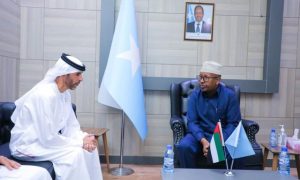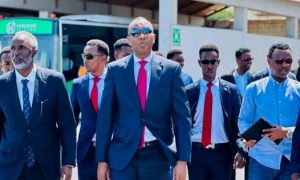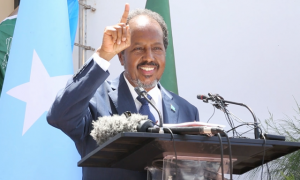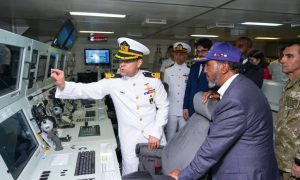
Muqdisho, May 17, 2016: As of late, Somalia’s counterterrorism efforts have enjoyed some notable successes. Security services in Puntland, an autonomous region of northern Somalia, fought off a large seaborne assault from al Shabab last March, killing 300 militants and capturing 100 fighters in the process. The same month, a U.S. airstrike killed more than 150 newly trained al Shabab combatants. A joint U.S.–Somali raid killed one of the organization’s senior members three days later.
But despite the recent victories against al Shabab, the group’s presence in Somalia has strengthened. Peacekeeping troops from the African Union Mission in Somalia (AMISOM) had pushed the group from its major strongholds over the past five years, but their offensive has stalled. AMISOM still occasionally liberates areas from the group’s control, but is sometimes unable to hold onto them. Al Shabab, meanwhile, has managed to kill hundreds of AMISOM troops, and has overrun three of AMISOM’s bases in the last ten months.
The Somali conflict has turned into a stalemate that benefits al Shabab. The country’s government is still too weak, dysfunctional, and corrupt to establish widespread credibility. AMISOM has been generally effective but lacks sufficient troops to exert consistent military pressure against al Shabab, and the Somali National Army (SNA) is unable to pick up the slack. This has allowed al Shabab to survive and continue its terror campaign that costs lives and stymies progress. The Somali government and the international community need to act urgently to ensure the costly, fragile gains of the last five years do not slip away.
END OF THE ROAD
Barring strategic changes, AMISOM’S offensive has gone as far as it can. The force consists of about 22,000 troops from five countries, as well as almost 400 police officers. Yet it is trying to subdue a terrorist group that operates throughout a country nearly as large as Texas. Counterinsurgency doctrine suggests that, given Somalia’s approximately 10 million inhabitants, at least 47,000 effective troops are required, meaning AMISOM is facing more than a 50 percent manpower shortfall. It also frequently suffers from a breakdown in basic military command and control. During attacks, troops often report to their home capitals before checking in with command and control in Mogadishu. This leads to confusion and delays that cost lives.
Countries participating in AMISOM sometimes put national self-interest above the coalition’s mission as well. Ethiopian forces operated independently from AMISOM inside Somalia for a number of years before eventually joining the coalition, and many Somalis are suspicious that Ethiopia wants to keep their country, historically Ethiopia’s greatest foe, weak and divided. And the United Nations alleges that the Kenyan Defence Forces defied an international ban on the the chargcoal trade, which finances much of al Shabab’s activities, in order to get a cut of the revenues.
The SNA should be the solution to some of these problems. Unfortunately, it remains largely ineffective and disorganized, save for a few elite units. The army was cobbled together from Somalia’s clan-based militias whose primary loyalty remains with their respective clans, rather than with the central government.
 Residents look at the wreckage of a car destroyed when Islamist militants opened fire on government officials in a car and then a car bomb exploded, according to police and a spokesman for Mogadishu’s mayor, in Yaqshiid district of Somalia’s capital Mogadishu, April 18, 2016.
Residents look at the wreckage of a car destroyed when Islamist militants opened fire on government officials in a car and then a car bomb exploded, according to police and a spokesman for Mogadishu’s mayor, in Yaqshiid district of Somalia’s capital Mogadishu, April 18, 2016.
The international community has spent hundreds of millions of dollars training the SNA to improve its capabilities, but to little effect. In fact, the training is a part of the problem. The African Union, European Union, the United States, and the United Arab Emirates have trained SNA units, leaving behind an army with little cohesion. Units receive different instructions and trains with different techniques, making coordination difficult.
POLITICAL GRIDLOCK
Somalia’s political challenges are equally difficult. The international community threw its support behind President Hassan Sheikh Mohamud in 2012, hoping he could provide a break from the string of corrupt, ineffective transitional governments of the past. The United States reestablished diplomatic ties with Somalia for the first time in 20 years, and a handful of countries, including China and the United Kingdom, reopened their embassies in Mogadishu. It was clear that rebuilding Somalia would be a challenge, but the conditions seemed better than they had in decades.
Mohamud’s government has proven to be a disappointment, however. In 2013, the United Nations accused his regime of being flamboyantly corrupt, claiming that 80 percent of Somali Central Bank transactions were fraudulent. The same year, Somali Central Bank Governor Yussur Abrar fled the country seven weeks into her post, claiming that her life was in danger after she thwarted attempts by high-ranking officials to loot the bank.
The government also spends too much time convulsed by power struggles and bickering. Mohamud forced two of the country’s previous prime ministers out of office due to disagreements over how power should be divided between the two offices, and Somali parliamentarians tried to have the president impeached on corruption charges in 2015. The disruptions have slowed the pace of important reforms. Parliament took more than a year and a half to pass a measure designed to bring transparency to public procurement. Other good governance measures, such as establishing an Ombudsman position to investigate government abuses, have languished as well.
BREAKTHROUGH SEASON
It will take tough adjustments to break Somalia’s political and military stalemates. Mogadishu must enact the promised anticorruption reforms, and prove it can advance a fair agenda through a political system fissured with clan rivalries. The government has been victimized by unclear constitutional provisions governing some of the most contentious issues, yet it needs to show more of the resiliency and statesmanship necessary for leading such a damaged and fractious country.
Creating a self-reliant and effective SNA must remain an urgent priority, as AMISOM cannot end its peacekeeping mission until an indigenous military can ensure security. A single country or organization should take responsibility for training the SNA, which would help improve its tactical abilities and culture. For now, however, AMISOM is still the country’s largest, most coherent fighting force. Its headquarters must facilitate better coordination among its constituent military contingents, which in turn must better observe command and control protocols by coordinating their actions through AMISOM. AMISOM should also be supplied with badly-needed airlift capability, the lack of which has contributed to its bases getting overrun and made it difficult to corner al Shabab. Finally, troop-contributing countries must surrender any agendas that do not wholeheartedly support a stable Somalia.
The international community and Somali government need to recapture the momentum they had in 2012. Otherwise, they will face further strengthening of a terrorist group that has killed thousands in Somalia and neighboring countries, and which at one point attracted recruits from around the world, including scores from the West. That would be a dangerous, unacceptable outcome.
Source:

Xafiiska Wararka Qaranimo Online | Mogadishu, Somalia
_____________________________________________________________________________________Advertisement
_____________________________________________________________________________________







